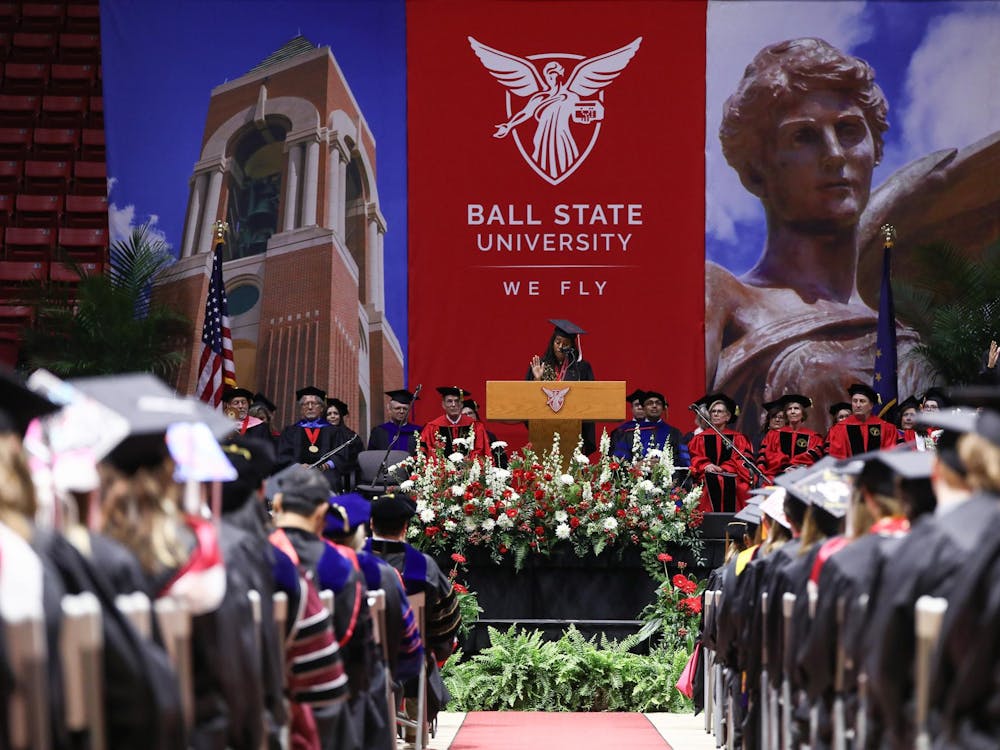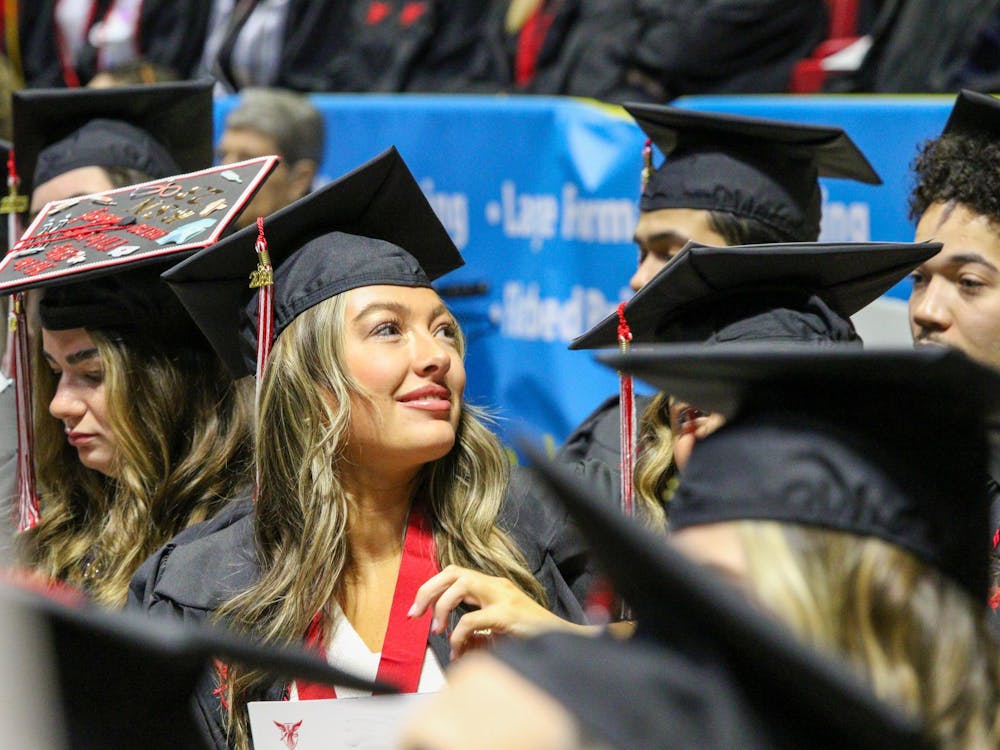Number of veterans enrolled at 6 Indiana universities
Indiana University
Veteran enrollment: *500 *
Total undergraduate enrollment: 32,371
Indiana State University
Veteran enrollment: *320 *
Total undergraduate enrollment: 10,076
*Ball State *
Veteran enrollment: *449 *
Total undergraduate enrollment: 16,652
University of Southern Indiana
Veteran enrollment: *233 *
Total undergraduate enrollment: 9,498
Vincennes University
Veteran enrollment: *180 *
Total undergraduate enrollment: 17,530
Purdue University:* 279*
Total undergraduate enrollment: *29,440 *
Facts about the GI Bill
• The GI Bill pays for veterans’ living costs and education tuition.
• The Post-9/11 GI Bill is the biggest investment in veterans’ education since World War II.
• According to the U.S. Department of Veterans Affairs, there’s been a 75 percent increase from 2008 of veterans using GI bills, due to the start of the Post-9/11 GI Bill in 2009.
• More than 260,000 students are attending about 6,000 colleges and universities this fall under the Post-9/11 GI Bill.
• The bill reached more than $30 billion in spending in July.
• On Nov. 8, the Post-9/11 GI Bill had reached the 1 millionth recipient mark with Steven Ferraro, a 10-year Army veteran who fought in the Iraq war.
Sources: defense.gov, U.S. Department of Veterans Affairs and newgibill.org
Five days after she completed military police officer training in 2007, Jessica Robinson was notified her unit would deploy to Kuwait.
She was 17 at the time. She couldn’t buy a pack of cigarettes if she wanted to, vote or enjoy a cold beer.
Robinson was in the Middle East from May 2008 until March 2009. When she arrived back in Indiana, she got her associate degree in criminal justice before enrolling at Ball State. Now, Robinson is working to earn a master’s degree in clinical mental health.
There were points when her GI Bill benefits, which funds veterans’ college and living costs, dangerously lagged.
“I went three months without a payment at one point,” she said. “If I did not have other forms of being able to get money, I would have been homeless. The [Department of Veterans Affairs] will tell you not to count on these payments, but most students have to.”
Robinson, who graduated in spring with her bachelor’s degree, said she believes the entire system through which veterans receive benefits, including the GI Bill, needs an overhaul. She’s not the only one.
In a time where more veterans are enrolling in higher education than ever before, the need for veteran accommodations is rising.
According to the VA, there was a 75 percent increase from 2008 of veterans using GI Bills, due to the start of the Post-9/11 GI Bill in 2009.
The bill reached more than $30 billion in spending in July.
In Indiana alone, six major universities have about 1,961 veterans enrolled this semester.
However, the VA is under scrutiny because of the lack of data the department is collecting on the academic progress of the veterans using the bill and whether they are obtaining degrees.
Richard Welch, a retired colonel and special forces officer, was accepted into Ph.D. Fellow in the Law and Democracy program in the Center for Constitutional Democracy at IU’s Maurer School of Law.
However, he hasn’t been able to begin earning his degree because he said his Vietnam-era GI Bill hasn’t provided him with an adequate amount of educational benefits.
“They said how much better it is now, opposed to how it was for Vietnam veterans,” Welch said. “But when you test this program, it’s not much better. The public support for the soldiers is better, but the VA is still antiquated. It’s a typical bogged down bureaucracy.”
The GI Bill benefits that are leading so many veterans, like Robinson, into a new life are sure to diminish if something isn’t done to keep support of the now $30 billion bill.
Chris Cate, advocacy group Student Veterans of America director of research, said historically, GI Bill benefits are either reduced or end a few years after the conflict.
In a Government Accountability Office report in May, auditors said without tracking the progress of these veterans in higher education, it’s difficult to “inform policymakers about the value veterans are receiving for the government’s substantial investment.”
In January, SVA partnered with the VA and National Students Clearinghouse and began building a database to track the success of student veterans, which will likely be done in February.
”Showing that the return on investment on the Post-9/11 GI Bill is high, in part through this project, then it may increase the likelihood that VA education benefits will remain strong,” Cate said.
However, some Indiana public universities have taken things into their own hands.
Beck Hannaford, Ball State veterans benefits and financial assistant coordinator, said the university has tracked its veteran graduation rate since 2008 and reports a 58 percent graduation rate for students enrolled for six years.
“We track this rate because graduation rates are a critical part of our mission of serving veterans,” Hannaford said.
Comparatively, the university reports 56 percent six-year graduation rate for all students, putting student veterans in the lead.
Hannaford said there is simple solution to combat slow GI Bill delivery: as the number of veterans using GI benefits rise, so should the number of VA employees serving the veterans.
“I could solve that problem tomorrow,” Hannaford said. “Since the GI Bill of 2009, the number of vets attending school has tripled, but the number of people processing has remained level. Increase the number of [VA] employees and install the computer system that they have been talking about for several years.”
James Brown, Indiana director of Veterans’ Affairs, said there are a number of reasons why the GI Bill could be late getting to students.
“It is a timing issue, sometimes, a funding issue,” Brown said. “There are steps to take to have paperwork in on time. So, close attention is needed to detail with timely filing.”
Other state universities have quickly recognized the need for this attention.
Margaret Baechtold, director of Veteran Support Services at IU, said about 500 students have identified as military or veteran students this Fall Semester.
Baechtold said IU is creating a system to better track the number of enrolled veterans and their graduation rates. She said several universities are capturing ways to track veterans with the growing interest of what happens after they leave the service and enroll in higher education.
While Baechthold said she has seen several veterans excel at IU, the transition can be tough, too.
“We have had some students who have come back and have found it very challenging to adjust physically and with the emotional issues they’re dealing with,” Baechthold said.
Robinson said she witnessed “horrific things in Iraq,” and it was difficult to resume to normal life after returning to civilian life.
“It was very hard to find people to relate to,” Robinson said. “It was easier to not talk to people. I was having a bad day because I had friends that could not call anymore because they had died.”
For IU student Curtis Hall, a 10-year explosive ordnance disposal squad veteran, his education provided under the GI Bill is a ticket to a new life. His goal is to become a cruise line manager, preferring the serenity of diving to explore coral reefs instead of diffusing bombs.
“I was trained and educated in a job that I now no longer want to be in,” Hall said. “But now I’m getting into tourism, I don’t want to be involved with anything that involves weapons or explosives.”
This fall, he began his three-four year journey to getting a tourism management degree at IU.
“In my lower level classes, I’m surrounded by 18-year-olds,” Hall said. “No one knows who I am and what I’ve done. I don’t wear it on my sleeve.”
Jason Thigpen, founder of the Student Veterans Advocacy Group said without the VA providing up-to-date numbers of student veterans, universities aren’t able to service the veteran population to its full extent.
For Ivy Tech Community College, which has 31 campuses in Indiana and about 5,487 veterans enrolled this semester, knowing the numbers has given it power to support vets.
Laura Vest, the statewide Ivy Tech veteran benefits coordinator, said during the government shutdown, tuition assistance for some army veterans was put on hold.
“Knowing who are students are and who is using benefits has given us the ability to help them with the unanticipated things that pop up, challenges along the way,” Vest said.
Ivy Tech tracks veterans attending, and its next step is to track how veterans are doing in degree completion. Vest said making a college vet-friendly is a “fluid, growing process.”
“We’ve identified the next challenge we need to tackle,” Vest said. “… We need to identify if there’s anything that stands out in veterans, good or bad. We need to go past the anecdotal response and we need to start pulling numbers.”




